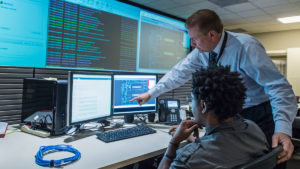The opportunity for Australia’s defence tech SMEs goes beyond AUKUS

The Australian Defence Strategic Review could be a once-in-a-lifetime opportunity for innovative small businesses to shift gears and go global. Pic via Getty Images.
Despite headwinds from the global economy, Australia’s defence technology innovators should focus on ambitious growth, according to archTIS CEO Daniel Lai
The war in Ukraine has sent shockwaves that are being felt everywhere, including in the recently released Australian Defence Strategic Review. Defence departments globally are making more investments not just into their own sovereign capabilities, but into forging deeper relationships with allies as well.
It’s a shakeup that will provide a once-in-a-lifetime opportunity for innovative technology providers with deep expertise in their field to demonstrate their value to Defence departments around the world.
The high-profile Australian example of this increase in investment is the AUKUS agreement, which enables Australia to acquire its first nuclear-powered submarines.
Perhaps more importantly, it also allows Australia to take part in strategic technology development and information sharing as pillar two of the program.
Australia is far from alone. Japan has increased its spending on defence from its historic 1% of GDP to 2%. This looks like a small number, but it has massive ramifications for defence suppliers, as our northern allies look to strengthen their defence alliances.
Ukraine conflict is changing the rules
This more holistic approach to defence is in reaction to the changing face of warfare. The war in Ukraine has revealed many things, most critically demonstrating the importance of fast, secure information sharing capabilities amongst allies. Information sharing within the ‘five eyes’ partners is one thing.
When and how to do it with nations that are non-traditional allies at varying levels of trust is another. It also makes that information an attractive target for enemy nation-state actors. Controlling which information should be shared, when, and with whom, is critical to the success of multilateral or coalition operations and national security.
The challenge is far more difficult than it first appears: each nation has disparate technology environments and security classifications hampering the ability to easily facilitate secure, real-time collaboration across coalition partners.
To address this, archTIS has developed the information-sharing technology platform Kojensi. It enables coalition partners and defence suppliers to securely share and collaborate on varying levels of classified information using a common file sharing and collaboration platform built to seamlessly address complex defence challenges.
Kojensi provides Zero Trust Data Centric Security. It uses attribute-based access control (ABAC) policies that can be based on any combination of user (i.e., security clearance, nationality, etc.), content sensitivity and environment (access point to information) values to dynamically determine who should be able to view information, and under what conditions.
It delivers the secure compartmentalised access and sharing required for multi-coalition and supply chain information exchange.
Raising internal data security standards to face external threats
A more holistic approach to defence means that defending, critical infrastructure, the supply chain and data, not just defence networks has greatly risen in importance. National cybersecurity threats are spilling over into private-sector risk mitigation.
A good example is Australia’s Security Legislation Amendment Critical Infrastructure Protection Act or SLACIP Act. It expands the list of what institutions are considered ‘critical infrastructure’ and greatly increases the level of protection required for those captured within its definitions, ranging from Utilities to Financial Services, and even Food and Grocery.
These massive, strategic investment decisions mean that Australia’s defence and cybersecurity technology SMEs no longer need to ‘break down the doors’ of potential customers. It’s now a case of making sure the innovative solutions they build fit into the bigger picture.
There are headwinds. Cybersecurity talent in particular is scarce. The overheads to take part in sensitive defence tenders are high and require a deep understanding of the industry.
These two factors will often require SMEs to collaborate with larger organisations or to utilise specialised security software services to meet these requirements and be able to participate.
Larger players will almost always have the advantage in our industry because of this.
None of these challenges are new. The difference is that the size of the opportunities available to SMEs is likely to grow at a far greater pace than we saw pre-pandemic, with increased access to supply to allied partners.
Global macroeconomic conditions aren’t favourable. But we must not let that narrative define the conversation locally. The stock market is a fickle master, but it reliably rewards those who can see the bigger picture and position themselves within it.
Australia has a fantastic position – both geopolitically and geographically – to take advantage of the biggest boom in defence and cybersecurity spending globally this century. It’s an exciting time to be an SME.
This article was developed in collaboration with ArchTIS, a Stockhead advertiser at the time of publishing.
This article does not constitute financial product advice. You should consider obtaining independent advice before making any financial decisions.
Related Topics
UNLOCK INSIGHTS
Discover the untold stories of emerging ASX stocks.
Daily news and expert analysis, it's free to subscribe.
By proceeding, you confirm you understand that we handle personal information in accordance with our Privacy Policy.








